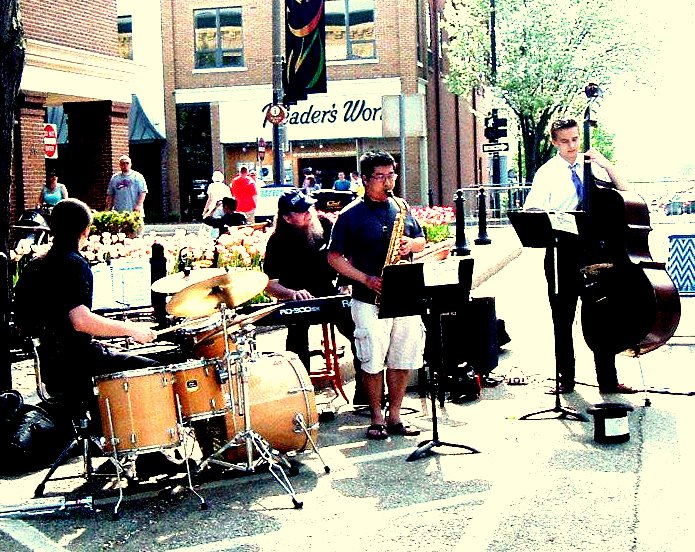
It’s a lovely rainy day in Western Michigan (actual photos taken today with my spiffy new netbook).

I was a bit happier with my playing with the quartet last night.

I made an effort to be more solid and a tiny bit more aggressive. This amounts to nothing more than not following some of the players when they messed up. I tried to play to the drummer and think a lot about rhythm and tempo as we played. Plus I was much happier with my comping and improvs.

I have been thinking quite a bit about Jazz theory. One thing that occurs to me is the imprecision of the notation. Here I’m thinking mostly about chords and the use of shorthand for complex ideas that often differ from usage to usage. I used to think that Jazz musicians (pianist especially) possessed a kind of preternatural harmonic instinct. I still think this is true of the great players like Peterson, Shearing, Tatum, and the many others I admire. But for us non-virtuoso “working” musicians, it now seems to me that the “code” of Jazz harmony is not that complicated as I used to think. A lot of the harmonies I am using in the quartet repertoire startle me because they are not as far-fetched or intricate as the harmonies of transcribed geniuses at the piano. Instead they relate directly to what I think sounds good and already occurs to me when I play.
My piano trio read through more Mendelssohn yesterday. We’re working on more movements of the D minor piano trio. The slow movement is not hard except that M does some fascinating things with moving back and forth from duple to triple rhythms that interlock better when the entire ensemble is expecting them. That was going much better in yesterday’s rehearsal. Then we read through the Scherzo. This movement will take some doing to learn. But when it’s done we will have a lovely Mendelssohnian scherzo under our belts.

I recently ran across this quote that shows that my understanding of Mendelssohn as a classicist was shared by Robert Schumann.
“He [Mendelssohn] is the Mozart of the nineteenth century, the most brilliant musician, the one who most clearly sees through the contradictions of the age for the first time reconciles them.”
Robert Schumann
Greg Vitercik puts this quote at the beginning of his essay, “Mendelssohn as progressive” in The Cambridge Companion to Mendelssohn, edited by Peter Mercer-Taylor
I did manage to work a bit on “Ebb and Flow,” the music for the Global Water Dance. In addition to just “resting-up” a bit in general I am trying to give myself some “creative” space for coming up with more specific ideas now that I have the structure designed. I’m hoping I can fill it in with ones that I like. This takes some of that stare out the window and watch time “ebb and flow” stuff.

I bought a Kindle edition of a book I am reading so that I can have it on my netbook (I use the Kindle for PC software). That way I could treadmill yesterday and pick up The Brothers Karamazov where I left off in the real book which has a type face I find difficult to see as I exercise. This is my second time through this book, at least. But I like the translation by Richard Pevear and Larissa Volokhonsky quite a bit.

I wonder how many people purchase ebooks and “real” copies of the same book like this?
*******************************************************************
Ancient Assyrian Dictionary Completed by University of Chicago Scholars – NYTimes.com
“It opens up for study “the richest span of cuneiform writing,” he said, referring to the script invented in the fourth millennium B.C. by the earlier Sumerians in Mesopotamia.
This was probably the first writing system anywhere, and the city-states that arose in the Tigris and Euphrates River Valleys, mainly in what is present-day Iraq and parts of Syria, are considered the earliest urban and literate civilization. The dictionary, with 28,000 words now defined in their various shades of meaning, covers a period from 2500 B.C. to A.D. 100.”
The whole thing is actually available for free online in PDFs!
*********************************************************************
Brain Calisthenics Help Break Down Abstract Ideas, Researchers Say – NYTimes.com
This article reminded me so much of my wife that I sent her the link. She has taught me to think conceptually and intuitively about abstract things like numbers and math.
I saw a biographical special on TCM on Dave Brubeck which was produced by Clint Eastwood. It was tremendous. Also, there was one on Thelonious Monk which was quite good and informative. I didn’t realize that Eastwood was such a devotee to Jazz. I have never been a Thelonious Monk fan.
It reminded me of the 5/4 measure in Brubeck’s “Take Five” that you taught me many years ago. Jazz is very structured and has a lot of rules, which most people do not realize. Paul Desmond’s sax in Take Five is outstanding. Any way just a side note.
We did “Monk’s Blues” by Thelonius Monk at our gig this week. No Brubeck. I have played and performed Brubeck’s “Blue Rondo A La Turk” in the last few years. It’s in an odd time feel as well 2+2+2+3. You may recall I played for a short time in a group called “August Train” (reformed briefly to as “Trilogy). They did this tune, “Blue Rondo,” but changed the feel to a more easy 2+2+2+2. At the time I didn’t think much of it. Now I think I would not want to do it that way. It changed it. I think I’ve seen one of Eastwood’s documentaries on blues piano players in which he plays a bit himself. Fun stuff.